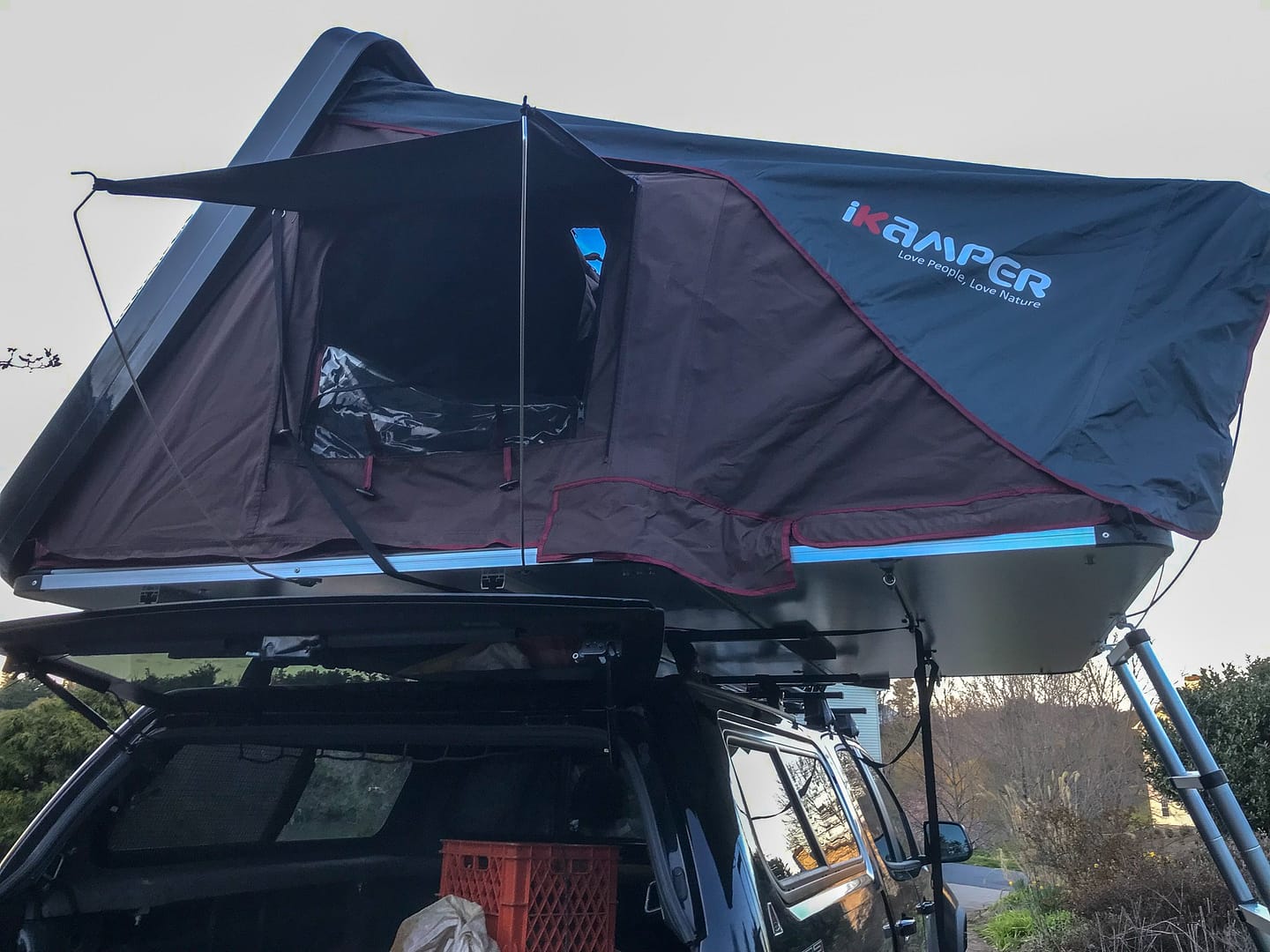3-29-19 The Fork Ridge trail leads from the Shelton Laurel backcountry to the Appalachian Trail, near the Jerry Cabin Shelter. If you want a good workout, this is your hike. Along the way, there is a side trail to Baxter Cliffs- well, sort of. It’s not much of a trail, and my guess is because it gets little use.
Time marches on, and this weekend marked another trip around the sun for me. We celebrated with an epic camping trip Friday night, followed by a spectacular 12.4 mile hike amidst the burgeoning spring wildflowers. I arrived home after my Thursday night workout, and was greeted by the iKamper, festooned with a giant red bow; a combined birthday, anniversary and Christmas gift for us both. Bernie and I first saw other versions of “rooftop tents” when we were in New Zealand, and we became very interested in this as a prelude to the (extremely costly) camper van of our dreams for retirement. I love it- more on the iKamper in a future post!







“Spring drew on and a greenness grew over those brown beds, which, freshening daily, suggested the thought that Hope traversed them at night, and left each morning brighter traces of her steps.”
Charlotte Bronte
We camped by Big Creek, in the Shelton Laurel backcountry, arriving there around 6pm and quickly setting up camp, as we had driven through rain on our way.
Fork Ridge
The morning dawned cold and cloudy, but a fire warmed us. We forded two streams on the forest service road to reach the Fork Ridge trailhead. Fork Ridge is an intense climb of 2000 feet in 2 miles to the Appalachian Trail, with very few switchbacks, so be prepared for near-constant steepness and screaming hamstrings and glutes.
There are only two places where you go downhill- not a relief at all, since you know have to regain that lost elevation. This trail is typically quite dry, but there were a few small branches early on, but be sure to bring plenty of water and extra if you are hiking with a dog.

As we were walking up the forest road, we could identify many wildflowers from their leaves, including Dicentra species, trillium, wood betony, toothwort, violets and trout lily. Finally, I spotted a solitary bloom of wild geranium.

As we climbed Fork Ridge, a few more wildflowers appeared, including spring beauty and round leaved violet. Bloodroot is in early bloom, and at this stage, often has its leaves clasped around the stem, as if praying for spring.


Another spring favorite is Heart-leaf Ginger, an evergreen with lovely variegated leaves and a calyx that hides under leaf litter. I was able to capture the calyx before opening and in bloom, but only by carefully brushing aside the litter.



Appalachian Trail- Firescald
The higher we went in elevation, the fewer wildflowers we saw, but the volume and spread of Trout lily leaves was astounding; unfortunately, they were not yet blooming. We reached the top of Fork Ridge and turned left towards Fire Scald on the Appalachian Trail. It was an otherwise wintry looking landscape outside of the presence of Spring Beauty. and warm temperatures. This was the most commonly found wildflower during the entire hike, regardless of elevation.


We hiked 4 miles along the ridgetop, on the AT and chose the blue side trail rather than going over Firescald Knob. I highly recommend this section; the views are gorgeous, on this windy and exposed ridge, and requires lots of rock scramble, so be prepared. These photos are from our last trip to Firescald.



Firescald is a route best taken outside of rattlesnake season. A few years ago, in late July, we happened upon a very large rattlesnake right by the trail and Bernie picked it up with my hiking sticks and flung him off the trail. Needless to say, he was less than pleased; I was shaking in my boots. Just a few hundred yards later, another hiker said he had just come across another rattler near the Jerry Cabin shelter. We were on high alert! Over the years, I have only seen 3 rattlesnakes on the trail and 2 copperheads over the years, so don’t let them deter you.


Baxter Cliffs
Well- let’s go back to something pleasant, like wildflowers. Under sunny and brilliant blue skies, we finished the 4 mile section where Firescald and the blue blaze trail merge. We turned left to the Jerry Miller Trail from the AT. This time we were taking a side route to Baxter Cliffs, which is a quarter mile steeply down and back each way.

About a mile down the Jerry Miller trail, you will reach a 4 way intersection and clearing with a rock fire ring. This is a great area to stop for lunch. On your right is a sign that only shows the tops of the letters “BAXTER CLIFFS”. I wrote the name and distance above it with a green sharpie. You don’t want to miss these views. It is a short hike down and back and well worth the effort.


After leaving Baxter Cliffs, the Jerry Miller trail continues down an old logging road, with several water sources. Be sure to follow the yellow blazes and double yellow blazes that indicate a change of direction, as the trail intersects with other logging roads. The trail now descends to Whiteoak Flats. As the name indicates, it is flatter, with plentiful water and native orchids later in the season.
Big Creek wildflowers
Perhaps the most fulfilling part of the day was when we reached the switchbacks that descend to Big Creek at the end of our hike. After being teased by Trout lily leaves without blooms all day, I finally saw ONE bloom among many leaves.


These switchbacks and the bottom area bordering Big Creek are simply crammed with wildflowers, either beginning or soon-to-begin their spring show. It is awe- inspiring to see so many species in one location!






This was a wonderful way to celebrate my journey through life, and the renewal and hope of spring. We are already considering options for next weekend’s hike adventure. I hope you’ll stay tuned for the next installment of wildflower exploration with HIKEscape!
See the previous post on Jerry Miller trail for directions; the Fork Ridge trail is located beyond the Jerry Miller trailhead that is accessed via Forest Service Road 111, by turning left off of Big Creek Road in Carmen, NC on NC Route 352.



2 Comments
Bernie · April 6, 2019 at 7:46 pm
One of my favorite training hikes to help get ready for the West.
I Like Big Blooms: They've Sprung at Big Ivy - HIKEscape · April 27, 2019 at 3:39 am
[…] species, Dutchman’s breeches (Dicentra curcullaria), have differently shaped flowers (see https://hikescape.org/fork-ridge-appalachian-trail-baxter-cliffs/) , with strikingly similar foliage but an earlier bloom time. Here is more information about these […]
Comments are closed.